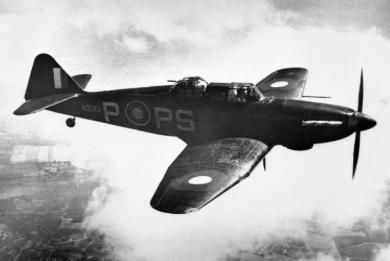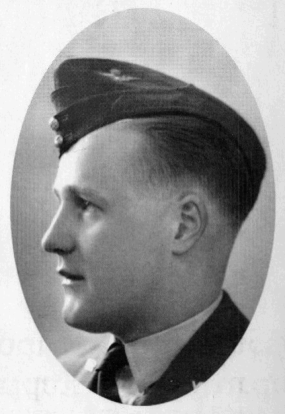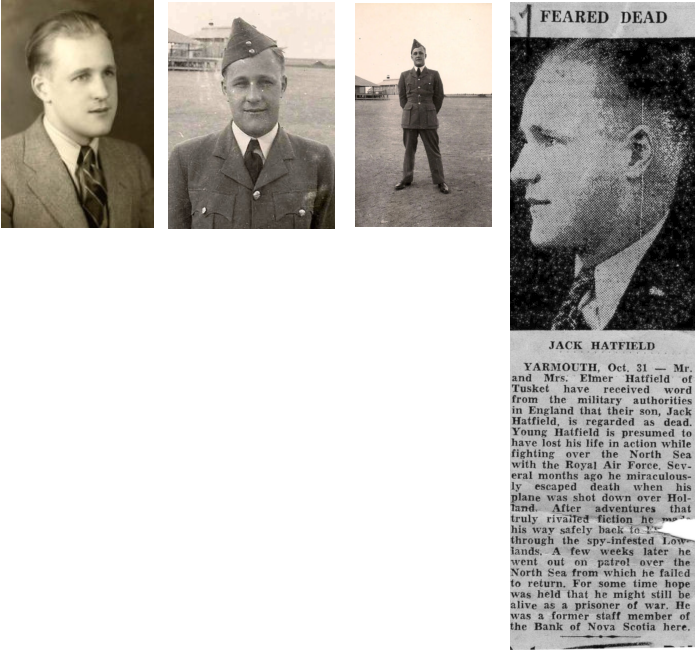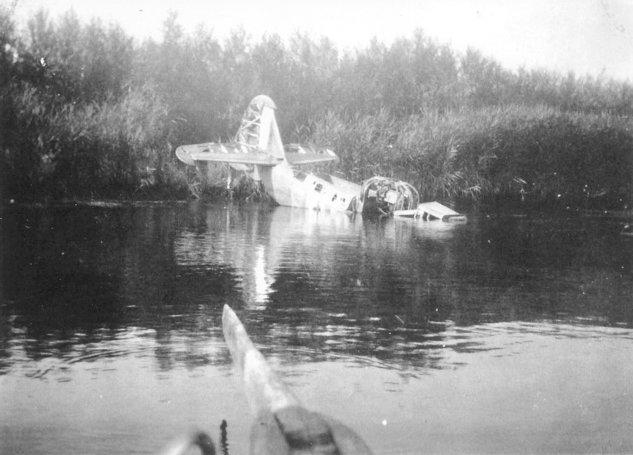
copyright © Wartime Heritage Association
Website hosting courtesy of Register.com - a web.com company
Wartime Heritage
ASSOCIATION
Remembering World War II
Yarmouth Connections


Name:
Jack Elmer Hatfield
Rank:
Pilot Officer (Air Gunner)
Service Number:
40474
Service:
264 Squadron, Royal Air Force
Date of Birth:
April 4, 1913
Place of Birth:
Tusket, Yarmouth Co., NS
Date of enlistment:
1938
Trade:
Banker, Bank of Nova Scotia
Marital Status:
Single
Date of Death:
May 28, 1940
Age:
28
Cemetery:
Becklingen War Cemetery, Germany
Grave:
26. D. 4.
Commemorated on Page 603 of the Second World War Book of Remembrance
Displayed in the Memorial Chamber of the Peace Tower in Ottawa on December 23
The 52nd name on the WWII list of the Yarmouth War Memorial
Jack Elmer Hatfield was the son of Elmer Calvin (1890-1967) and Enola Vaughan (Forbes) Hatfield (1886-
1966), of Tusket, Yarmouth County, Nova Scotia.
Jack entered service with the Bank of Nova Scotia on August 1, 1929 at the age of 16. He was an
Associate of the Canadian Bankers Association (A.C.B.A.).
There is a record of him travelling from to Quebec to London, England aboard the SS Briarwood (of the
Constantine Line), arriving August 21, 1937. He indicated his address was 21 Bury St. in London. He
enlisted with the Royal Air Force sometime in 1938.
He arrived in London, England July 4, 1938 having boarded in Port Said, Egypt, to RAF Depot Uxbridge
England landing in London England aboard MV Shropshire (of the Bibby Line). The ship’s original port of
departure was Rangoon, Burma.
He departed Liverpool, England aboard the steamship RMS Nova Scotia (of the Furness Line) on July 14,
1938 bound for Halifax, NS. It is not clear when he returned to England prior to the start of the Second
World War, but he has already serving in the RAF when the war began having enlisted in 1938.
Acting Pilot Officer Hatfield was graded as a Pilot Officer on March 16, 1940 while in England. (Recorded
in the London Gazette, June 4, 1940)
With the opening of the enemy offensive on May 10, 1940, Jack Hatfield’s 264 Squadron moved south to
Duxford. The RAF had 58 Defiants, but not all were combat ready. Jack took part in the first sortie of
264 Squadron with Fight Lieutenant Skelton but no enemy contact was made and they landed an hour
later.
The events of May 13, 1940:
The squadron planes took off at 0415 hrs
from Martlesham along with five other
Boulton Paul Defiants and six Spitfires from
66 Squadron. The objective was to patrol
the Dutch coast between IJmuiden and the
Hague to attack enemy troop transport.
They flew across the North Sea, making
landfall about ten miles north of The Hague
at 0515, after which all aircraft turned
north.
Over IJmuiden they were fired on by Dutch anti-aircraft guns located on the south side of the harbour.
The guns were firing accurately but they ceased fire immediately the British signalled the Dutch letter of
the day. All aircraft turned about and flew south along the coast. More fire, this time from the enemy,
was encountered over Maassluis which caused sections to take evasive action.
Shortly after, the No. 66 Squadron Spitfires turned east towards Rotterdam where there were fires raging
in various places while the Defiants followed a more southerly route. Approaching Rotterdam, the crews
of both flights saw about seven enemy Ju 87 Stukas, belonging to 12. Staffel of Lehrgeschwader 1, dive-
bombing a target to the south-east.
Ju 87 Stukas, belonging to 12. Staffel of Lehrgeschwader 1, dive-bombing a target to the south-east.
The Defiants went into an attack and a ferocious air battle developed. Shortly after, Bf 109's from 5.
Staffel of Jagdgeschwader 26 joined the battle, which then developed into a series of individual
dogfights.
Hit by fire from enemy fighters, the pilot of Blue 1, Flight Lieutenant George Skelton, lost consciousness
and the aircraft went into a spiral dive. His gunner, Pilot Officer Jack Hatfield, tried in vain to contact his
pilot and finally abandoned the plane. He later filed the following report:
“I was air gunner to Flight Lieutenant Skelton who was leading the formation of Defiants during
the operations May 13, 1940. Skelton was leading 'B' Flight of No. 264 Squadron. We encountered
near Rotterdam, at about 0545 hours, seven Ju 87s and about 25 Me 109s. About two miles from
Rotterdam the Defiants had to break formation as a dogfight had developed.
When we were attacked by one Ju 87 who was on our tail about 50 yards away, I told Flight
Lieutenant Skelton to bank away but received no reply. At the same time another Ju 87 came up
on our tail accompanied by an Me 109 on the left. I shot down the first Ju 87. By this time our own
aircraft was in a steep spiral turn and the second Ju 87 continued to follow us.
‘I could not get in touch with Skelton so I think he was probably killed in the first encounter. Our
aircraft started to spin and I managed to escape from the top of the turret with only one door
open. I must have pulled my parachute automatically because I was not conscious until I landed in
some water. I remember that the Ju 87 was firing incendiary bullets and my elbow was injured.
‘I swam ashore and stayed in the reeds for about two hours and then swam to another island.
While in the water I saw a boy and a girl in a boat [Piet and Iet Saarloos] who took me to their
house. I questioned the man of the house and by sign language was told that three English and one
German parachute had come down. Apparently, our aircraft had spun in about one mile from this
house and had blown up. The name of this place was Biesbosch. I tried to bribe the man to take
me to the crash to see if my pilot was dead or wounded, but I was assured that the aircraft had
exploded and the people would not take me across the river.
‘At about 1200 hours I was rowed across the river by one of the neighbours and was met by two
boys on bicycles [Martien van Lent and Piet Saarloos] who took me on the back of one to the
place where I met Pilot Officer Thomas of Blue 2. I noticed that most German aircraft were flying
at about 1,500 feet. There was no opposition and very little anti-aircraft fire. All the Dutch
military that we encountered appeared to be very angry that the English had not given them more
air assistance.”
Pilot Officer Hatfield returned to England the day after he was shot down. Together with Pilot Officer
Samuel Thomas of Blue 2, he was able to secure a place aboard a British warship that left Hook of
Holland late on the 13th and arrived at Dover the following evening. Both men rejoined No. 264
Squadron.
May 23 – 26, 1940
On the afternoon of May 23, the squadron took off from RAF Manston, Kent County in South East England
to cover the French coast over Dunkirk, Calais, and Boulogne. Hatfield flew with pilot Sergeant John
Lander. Seven Messerschmitt Bf 110s were spotted and one of them dove to break up the British
formation. The other six followed but seeing that the Defiants maintained good formation they climbed
back into clouds. That evening the squadron flew a similar patrol together with two Hurricane squadrons,
but no enemy aircraft were sighted.
From May 26 to June 3 there were almost constant air battles over Dunkirk, as part of the aerial cover
for Operation ‘Dynamo’, the evacuation of the British Expeditionary Force from France. The Defiants of
No. 264 Squadron were heavily involved. May 29 proved to be a big day when they claimed eight Bf
109s, nine Bf 110s and one Ju 87. However, Jack Hatfield did not live to see that day.
The events of May 28, 1940
On May 28, Hatfield had taken off from RAF Manston with Pilot Officer Alexander McLeod in Defiant
L7007 to patrol Dunkirk. They failed to return from a combat with Bf 109s having been shot down in the
English Channel – in the sea north west of Dunkirk. Pilot Officer (air gunner) Hatfield's body later washed
ashore and he was buried in Germany. His remains were re-interred after the war in Becklingen War
Cemetery at Soltau, Germany.
Pilot Officer Alexander McLeod, has no known grave and his name appears on Panel 9 of the Runnymede
Memorial.
Jack Hatfield was the first Nova Scotian and the third Canadian to die in aerial combat during the Second
World War.
Jack’s brother Tracy Hatfield was shot down, almost two years to the day that Jack died, on May 28,
1942 during an air raid over Cologne, Germany and was a POW at Stalag Luft III. He survived the war
and returned to Canada. He died in 2005 at the age of 85.
Yarmouth resident Tracy Hatfield wrote about the wartime experiences of his father, Tracy and his
uncle Jack for “The Argus”, the quarterly newsletter of the Argyle Municipality Historical and
Genealogical Society. His article on Jack Hatfield appeared in the winter 2007 edition (Volume 19,
Number 4). His two-part article on Tracy Hatfield appeared in the summer 2008 (Volume 20, Number 2)
and fall 2008 (Volume 20, Number 3) editions.

Jack Elmer Hatfield


Sources:
Veterans Affairs Canada
Air Crew Remembrance Society
The Boulton Paul Defiant: Day and Night Fighter, by Phil H. Listemann



- World War I - Menu
- WWI Stories and Articles
- Photos - Yarmouth Soldiers
- Selection of World War I Songs
- WWI Casualties of Yarmouth, NS
- Those Who Served - Yarmouth, NS
- WWI Casualties Digby Co. NS
- WWI Casualties Shelburne Co. NS
- Merchant Mariners (1915) Yarmouth, NS
- Canadian Forestry Corps - Non Yarmouth Birth/Residence Enlistments
- US Draft Registry - Yarmouth NS Born


- World War II - Menu
- WWII Stories and Articles
- Telegraphist Air Gunners
- WWII Casualties of Nova Scotia
- US Casualties with NS Connection
- Far East/Pacific Casualties with NS Connection
- Merchant Navy Casualties Nova Scotia
- Nova Scotia WWII Casualties Holten Canadian War Cemetery
- D-Day Casualties - Nova Scotia
- CANLOAN Program Casualties - Nova Scotia
- Battle of the Bulge Casualties - Nova Scotia
- WWII Casualties Yarmouth NS
- Yarmouth Casualties - RCAF RAF Canadian Army WWII
- Yarmouth Co., Marriages WWII
- Casualties Non-Born/Residents with Connection to Yarmouth Co., Nova Scotia.
- WWII Casualties Digby Co., NS
- Non-Nova Scotian WWII Casualties Buried in Nova Scotia
- WWII RCAF Casualties Aged 16-18
- Brothers/Sisters Who Served - World War II














